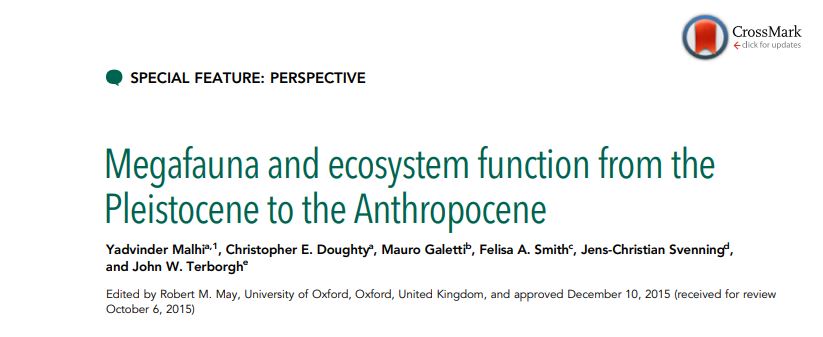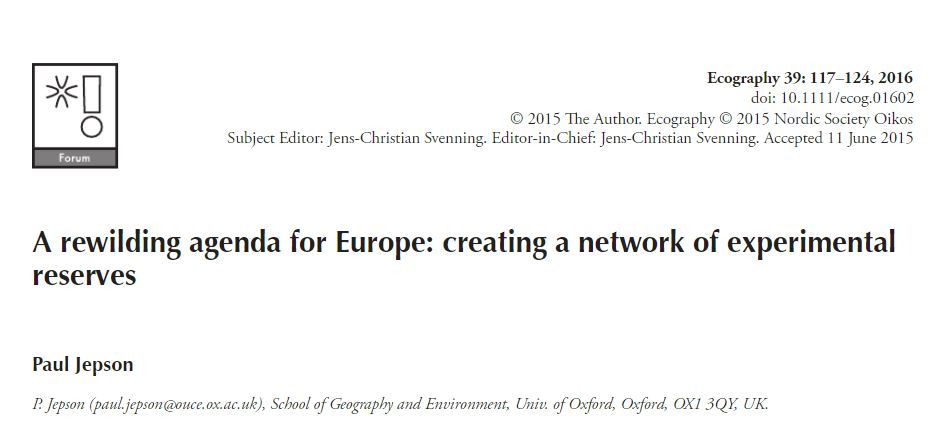
Prehistoric or historic? What is the best baseline for #rewilding in the Neotropics? @JCSvenning and @FaurbySoren investigate the previous distribution of megafauna to inform future options of trophic rewilding in today’s #rewildingscience thread 

Trophic rewilding – use of species to promote trophic cascades and self-regulating ecosystems often involves discussion around megafauna (large bodied species). Their high mobility, resitance to top-down effects, and ability to disperse nutrients makes them ecologically valuable
It is these species that have been subject to anthropogenic declines, including in the Neotropics. Historic baselines for species richness and distribution are now so intermingled with human effects that they may not represent a feasible point to base introductions on…
Despite this, the authors write, forward-looking rewilding agendas should be historically informed, using knowledge of regional species over long timescales to understand environmental conditions at which they are adapted to
This can take the form of Pleistocene rewilding (looking beyond historic baselines i.e. 5000-50,000 ya). Why? Whilst 5000-10,000y is a decent amount of time, biota adaptations will have occurred over much longer timescales, with faunal states developing across millions of years
This paper looks into the two baselines that can be used in the Neotropics. This part of the world has seen strong pre-historic late-quaternary losses including; ground sloths, giant armadillos, horses, and varied carnivores…
To research the suitability of the baselines, data from historically extinct (post-1500 AD) and extirpated extant megafauna, as well as extinct megafauna from the late Pleistocene-Holocene are used to map out rewilding potential and species richness
3 body size groups for herbivores were used in this analysis; meso- (10-99kg), macro- (100-999kg) and mega-herbivores (>1000kg). Carnivores are similarly categorised, with overall megafauna separated out into 3 diversities; current, historic baseline, and pre-historic baseline
The results suggest high potential for trophic rewilding across all of the Neotropics, particularly throughout the pre-historic baseline estimates. Extinct or extirpated species with large potential ranges include proboscideans, horses, camelids, large deer, and large canids... 

The potential for rewilding varied across biomes, with the highest values being found for tropical and sub-tropical grasslands, savannahs, and shrublands under the prehistoric baseline. Potential was found to also be high for various tropical and subtropical biomes 



Importantly, the estimated present-natural distributions show reduced diversities of meso-,macro-, and megacarnivores and herbivores relative to both prehistoric and historic baselines. No megaherbivores are left today in the region meaning missing ecosystem-engineer effects
There is therefore potential for use of trophic rewilding using recently extirpated species e.g. re-faunation of ‘empty’ forests. For prehistoric baselines, the biome of tropical/subtropical grasslands, savannas and shrublands have particularly high rewilding potential (>30 sp)…
Use of a prehistoric baseline may also provide greater functions due to higher group diversity. Within the megaherbivores, >20 sp are recorded from the region, compared to 10 extant sp globally. Including smaller herbivores, variability in effects on ecosystem structure increases
In terms of reintroductions, many small to moderately sized extant vertebrate species can be considered in restoration projects as relatively unproblematic options. This can be largely-based on a historic baseline due to widespread defaunation across the region…
However, data suggests that even a pre-defaunation historical baseline is still an unusually megafauna-poor state. There’s a strong argument for end-Pleistocene/early Holocene baseline as a starting point for restoration, as it was under these conditions that biodiversity evolved
They conclude by acknowledging that rewilding is dependent on biological and societal possibilities/constraints. Trophic rewilding must be compatible with society. Landscape circumstances will also effect how rewilding can be implemented; the amount of land available being key
Generally, reintroductions toward a historic baseline are more simple, using extant and often nearby species. However, they argue, it is worth considering if prehistoric losses could be partially overcome using taxon substitutions to reinstate lost processes
We unfortunately couldn’t cover everything in this paper, so please follow the link to have a read and a good look at the figures! We’d love to hear your thoughts and get a discussion going.
Full paper: researchgate.net/publication/32…
Full paper: researchgate.net/publication/32…
• • •
Missing some Tweet in this thread? You can try to
force a refresh









